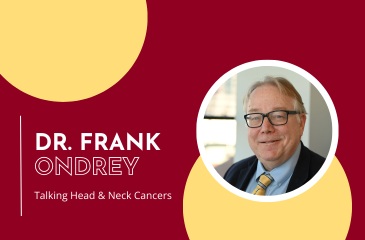Critial aspects of head and neck cancers with Dr. Frank Ondrey
April is Oral, Head, and Neck Cancer Awareness Month. This month we sat down with MCC’s Dr. Frank Ondrey, a leading head and neck cancer surgeon and otolaryngologist at the University of Minnesota, to chat about critical insights into the complexities of head and neck cancer, covering topics from risk factors and prevention to innovative treatment strategies. Dr. Ondrey is the special expert guests at our next Fireside Chat, happening April 17!
Could you give us a brief background on your education, what intrigued you about your field of specialty, and what brought you to the University of Minnesota?
I came to the University of Minnesota, Department of Otolaryngology after finishing my MD/PhD program in Chicago, specifically to complete an otolaryngology residency and be mentored by Dr. George Adams, one of the most innovative head and neck cancer surgeons and clinical trialists at the time.
What are head and neck cancers and how are they diagnosed?
When we use the word head and neck cancer we are specifically referring to cancers of the lining tissues of the mouth and throat. They typically begin at earliest stages as painless white lesions that can be present for a very long time. The earliest stages are typically painless so they might only be incidentally discovered by physicians and dentists. In fact the lesions that are painful are typically the most benign, and may be cold sores, autoimmune conditions, infections of the teeth and gums, or conditions like thrush. In fact when examining our referral populations on a recent search over 100 separate diagnoses are searched for oral cavity lesions with only a few of them being high risk for cancers. Persistent lesions that progress symptomatically are biopsied when they have a suspicious appearance. However, approximately 90% of our referral patients come to clinic with advanced disease and invasive cancer at the outset.
What preventative measures can people take to lower their risk of head and neck cancers?
Substantial tobacco use, alcohol use over time, should be minimized as they are the largest risk factors, as well as the emergence of HPV infections that can turn into cancer. However, other risky precursor conditions exist like organ or bone marrow transplantation, graft versus host disease, immune conditions like oral lichen planus, and high risk conditions like Fanconi anemia. In cultures outside of the U.S. certain cultural practices like areca nut chewing are high risk as well.
What health disparities exist regarding head and neck cancers?
Like most cancers, underserved groups will often present with more advanced head and neck cancer and whether there are racial biological differences, versus access issues is unclear, but likely the causes are multifactorial.
How is your research at the Masonic Cancer Center advancing understanding of head and neck cancers and how we prevent/diagnose/treat them?
I have been funded by the National Cancer Institute to perform several of the oral cancer prevention trials that have been funded over 20 years. Much of this work was initiated by my team's own bench research in the lab. Additionally, we have had about 6,000 suspicious lesion referral patients over time that are under some level of surveillance. I have treated around 2,500 cancer patients over this time as well. We actively seek preventative measures, but oftentimes these patients show up in clinic with advanced disease, even when under good dental or other surveillance as well as knowledge of the risks of lesions becoming cancer, which makes the disease even more sinister.
